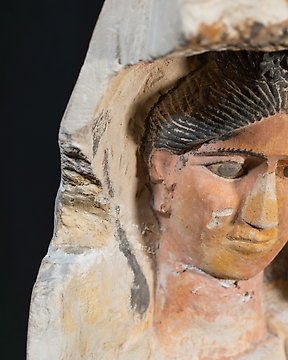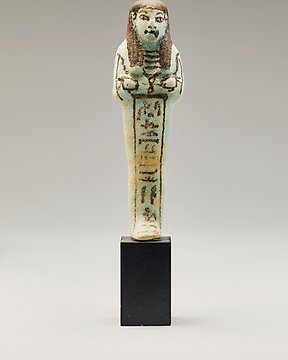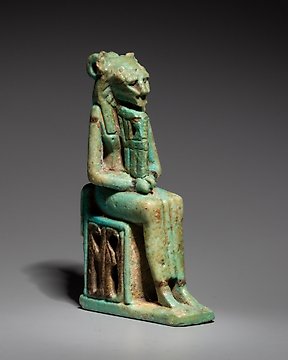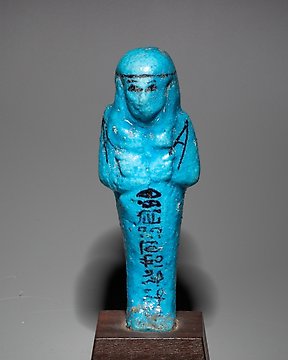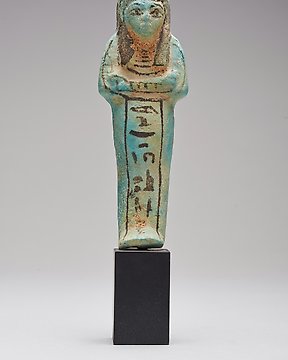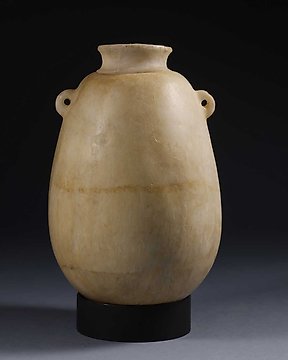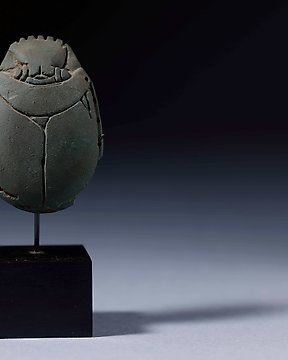Always a great pleasure !
查看翻译古埃及,晚期 霍鲁贾的乌沙布蒂彩陶,14.3 厘米 - 出自亚历山德罗·巴尔桑蒂收藏 - Shabti
编号 85147339



Ancient Egyptian funerary statuette with a mummy-shaped body and back column resting on a small base plate. Modelled details, wearing a tripartite wig with visible ears, beard attached. Arms crossed in front of the chest, holding a farming tool in each hand and a basket of seeds behind her back. Just below the hands begins the inscription diligently engraved on three vertical columns: Wab priest, chief of the feasts, prophet, son of Isetenkhebi.
The tomb of Udja-Her was excavated at Saqqara in 1902 by Alessandro Barsanti, who a year earlier had found the tomb of Hekaemsaf near the Pyramid of Unas, with shabtis stylistically identical to those of Hekaemsaf. Therefore, the shabtis come not only from the same period, but also from the same workshop.
Alessandro Barsanti (1858-1917) was an Italian architect and Egyptologist who worked for the Egyptian Antiquities Service. He carried out excavations throughout Egypt (in particular, he ‘discovered’ the tomb of Akhenaten in 1891-92). He was also responsible for the transfer of the collection of the Cairo Museum from its site in Giza to its present location in Cairo itself.
Unlike the more common Hekaemsaf shabtis, very few Udja-Her shabtis are known.
Little is known of Horudja. His shabtis can be dated to the 26th Dynasty, so he lived around 600 BC. His mother's name, Khaw-si-en-Hap, according to Yoyotte can be translated as ‘she has lain down in front of Apis’, the meaning of which remains unclear. His tomb was probably discovered in the late 19th Century.
Condition: Restored lower part and some marks under the arms.
Provenace: From the same workshop as the famous Hekaemsaf shabtis. It was found by Barsanti in 1903 near the Unas Pyramid in Saqqara // Collection K.R. Reinland Pfalz, Germany. Collected before 1980 // BB-Antiken & Asiatica, Germany, 2014 // Former Collection T, W., Germany, 2024
58 Horudja shabtis are now in the Manchester Museum in England. The Art Institute of Chicago also owns one, ref. no. 1890.30; another, object no. 2005.025.001, is in the Michael C. Carlos Museum, Atlanta, USA. For one in a private collection, see Sotheby's shabti of 6 July 2021, lot 127.
Library:: J. F. Aubert and L. Aubert, Egyptian Statuettes, Paris, 1974.
Statement seen by Catawiki. The seller guarantees that he is entitled to ship this lot. The seller will take care that any necessary permits will be arranged. The seller will inform the buyer about this if this takes more than a few days.
According to Spanish legislation, items sent outside the European Union are subject to export taxes and will be added to the invoice, at the buyer's expense.
These export fees are fixed on the final auction price and the tax rate is not applied directly on the total value of the item to be exported, but rather the different percentages by sections are applied to it:
- Up to 6,000 euros: 5%.
- From 6.001 to 60.000 euros: 10%.
Due to Switzerland customs regulations about antiques over 100 years old, this lot cannot be sold to customers residing in Switzerland.
Ancient Egyptian funerary statuette with a mummy-shaped body and back column resting on a small base plate. Modelled details, wearing a tripartite wig with visible ears, beard attached. Arms crossed in front of the chest, holding a farming tool in each hand and a basket of seeds behind her back. Just below the hands begins the inscription diligently engraved on three vertical columns: Wab priest, chief of the feasts, prophet, son of Isetenkhebi.
The tomb of Udja-Her was excavated at Saqqara in 1902 by Alessandro Barsanti, who a year earlier had found the tomb of Hekaemsaf near the Pyramid of Unas, with shabtis stylistically identical to those of Hekaemsaf. Therefore, the shabtis come not only from the same period, but also from the same workshop.
Alessandro Barsanti (1858-1917) was an Italian architect and Egyptologist who worked for the Egyptian Antiquities Service. He carried out excavations throughout Egypt (in particular, he ‘discovered’ the tomb of Akhenaten in 1891-92). He was also responsible for the transfer of the collection of the Cairo Museum from its site in Giza to its present location in Cairo itself.
Unlike the more common Hekaemsaf shabtis, very few Udja-Her shabtis are known.
Little is known of Horudja. His shabtis can be dated to the 26th Dynasty, so he lived around 600 BC. His mother's name, Khaw-si-en-Hap, according to Yoyotte can be translated as ‘she has lain down in front of Apis’, the meaning of which remains unclear. His tomb was probably discovered in the late 19th Century.
Condition: Restored lower part and some marks under the arms.
Provenace: From the same workshop as the famous Hekaemsaf shabtis. It was found by Barsanti in 1903 near the Unas Pyramid in Saqqara // Collection K.R. Reinland Pfalz, Germany. Collected before 1980 // BB-Antiken & Asiatica, Germany, 2014 // Former Collection T, W., Germany, 2024
58 Horudja shabtis are now in the Manchester Museum in England. The Art Institute of Chicago also owns one, ref. no. 1890.30; another, object no. 2005.025.001, is in the Michael C. Carlos Museum, Atlanta, USA. For one in a private collection, see Sotheby's shabti of 6 July 2021, lot 127.
Library:: J. F. Aubert and L. Aubert, Egyptian Statuettes, Paris, 1974.
Statement seen by Catawiki. The seller guarantees that he is entitled to ship this lot. The seller will take care that any necessary permits will be arranged. The seller will inform the buyer about this if this takes more than a few days.
According to Spanish legislation, items sent outside the European Union are subject to export taxes and will be added to the invoice, at the buyer's expense.
These export fees are fixed on the final auction price and the tax rate is not applied directly on the total value of the item to be exported, but rather the different percentages by sections are applied to it:
- Up to 6,000 euros: 5%.
- From 6.001 to 60.000 euros: 10%.
Due to Switzerland customs regulations about antiques over 100 years old, this lot cannot be sold to customers residing in Switzerland.
- 22
- 1
- 0
l'objet est conforme à sa description et il est arrivé rapidement.. seul bémol, les documents qui accompagnent l'objet sont de simples impressions noir et blanc....
查看翻译Emballage meilleur que la dernière fois mais figurine vendue sans support
查看翻译Todo correcto
查看翻译Always perfect !
查看翻译Envío muy rápido
查看翻译thank you for this wonderful artifact
查看翻译absolute wondeful.
查看翻译Very good price Very Friendly Very fast shipping
查看翻译well packed and nice piece!
查看翻译alles gut, danke
查看翻译⭐️⭐️⭐️⭐️⭐️
查看翻译Perfect, empatic, gorgeous Seller. I loved him.
查看翻译Muy contento
查看翻译Envoi soigné, cette pièce est superbe !
查看翻译Great items, and well packed.
查看翻译great object great experience
查看翻译